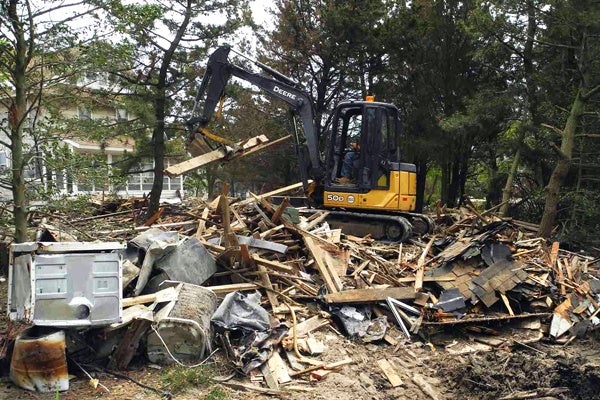Jersey Shore towns begin mass demolition of storm-damaged homes
One of the most damaged municipalities along the shore, Mantoloking, New Jersey, still bears the marks of Superstorm Sandy. Many houses sit unevenly in the sand, as if knocked off their foundations by some rampaging giant. Some rooflines rest directly in the sand.
“A conservative estimate on folks that will be to be rebuilt, out of 528 [homes] in town, we’ll probably have to rebuild a third of our housing stock,” said Chris Nelson, special counsel to the mayor of Mantoloking.
As Memorial Day approaches, many homeowners are anxious to rebuild their Sandy-damaged homes. But before construction can begin, there’s still a lot of deconstruction to do – to clear the homes damaged beyond repair and the large swaths of debris and sand that the storm left behind.
Typically, storm damage on private property is the homeowner’s responsibility, but when the destruction is so widespread that it becomes a safety hazard, as in Mantoloking, FEMA steps in. Mantoloking is the first town to get its program up and running under FEMA’s Private Property Debris Removal program. FEMA pays at least 75 percent of the cost of demolition and debris removal. The town’s picking up the rest. Over 50 homes will be torn down and debris cleared from another 43. It’ll take a month and a half and cost $2.8 million.
Many homeowners are still deciding if and how to rebuild, whether to demolish their homes or try to repair them. It’s part of the reason the storm damage here looks so fresh.
“Look in this home, here’s their outdoor shower with the shampoo bottle still attached.” Nelson said, pointing to a heavily damaged home from the seat of his truck. “You can see hangers in people’s closets with clothes on them and it’s horrible. It’s horrible that’s it’s six months after the storm and you’re still seeing it.”
During the storm, the ocean broke through the Mantoloking’s two-mile stretch of the barrier island to connect with Barnegat Bay in three places. The municipality was without gas, electricity, and water for almost four months.
“We thought the town would be inaccessible until summer,” said Nelson.
To start these mass demolitions, the municipality needed consent from homeowners, insurance documentation, site surveys, and FEMA approvals, among other steps.
Raif Basilious is a civil engineer overseeing Mantoloking’s demolition work. He watches an excavator push a mound of debris into the scoop of a wheel-loader. Thre’s lots of small chunks of wood and even a pillow.
“The big home takes two hours to be completely demolished,” Basilious explained. “But to remove the debris out could take two days.”
A small home might come down in an hour and fit in just two dump trucks.
If it sounds sad, it is. But these demolitions are also a fresh start – literally and symbolically wiping the slate clean – so people can move on.
There are signs that life is starting to normalize. Many streets are still closed, but the cherry trees bloomed this spring. A UPS truck has been making deliveries. The beaches will reopen in mid June.
More than 20 municipalities are taking to FEMA about projects similar to Mantoloking. Just this past weekend, Ortley Beach started taking down 50 homes. That number could eventually grow to over 200.
WHYY is your source for fact-based, in-depth journalism and information. As a nonprofit organization, we rely on financial support from readers like you. Please give today.













